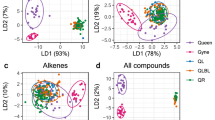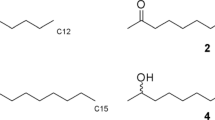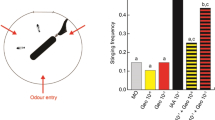Abstract
THE exocrine glands of ants are often found to contain blends of volatile chemicals1, but only rarely have distinct releaser properties been ascribed to different components of a single gland2–4. The African weaver ant Oecophylla longinoda is notoriously aggressive in defending its territory, and communication of alarm is rapid and efficient. Colony defence is carried out almost exclusively by the major workers, the minor caste remaining within the leaf-nest until this is directly disturbed5. This marked difference in behaviour may reflect a biochemical polymorphism, although this has not yet been reported for alarm pheromones of ants6. We have therefore initiated a detailed study of exocrine secretions that could be implicated in the control of alarm and defence in this ant. In the mandibular gland we have found over thirty compounds, some of which control separate aspects of behaviour. The mandibular gland contents also differ markedly among castes.
This is a preview of subscription content, access via your institution
Access options
Subscribe to this journal
Receive 51 print issues and online access
$199.00 per year
only $3.90 per issue
Buy this article
- Purchase on Springer Link
- Instant access to full article PDF
Prices may be subject to local taxes which are calculated during checkout
Similar content being viewed by others
References
Blum, M. S., Proc. 7th Int. Congr. IUSSI, Lond., 23–40 (1973).
Tricôt, M. C., Pasteels, J. M., and Tursch, B., J. Insect Physiol., 18, 499–509 (1972).
Cammaerts-Tricôt, M. C., ibid., 19, 1299–1315 (1973).
Leuthold, R. H., and Schlunegger, U., Insectes sociaux, 20, 205–214 (1973).
Weber, N. A., Ecology, 30, 397–400 (1949).
Crewe, R. M., Proc. 7th Int. Congr. IUSSI, Lond., 77–83 (1973).
Wilson, E. O., Bossert, W. H., and Regnier, F. E., J. Insect Physiol., 15, 597–610 (1969)
Baker, R., Bradshaw, J. W. S., Evans, D. A., Higgs, M. D., and Wadhams, L. J., J. Chromatogr. Sci., (in the press).
Baker, J. T., Blake, J. D., MacLeod, J. K., Ironside, D. A., and Johnson, I. C., Aust. J. Chem., 25, 393–400 (1972).
Bossert, W. H., and Wilson, E. O., J. theor. Biol., 5, 443–469 (1963).
Morgan, E. D., and Wadhams, L. J., J. Chromatogr. Sci., 10, 528–529 (1972).
Author information
Authors and Affiliations
Rights and permissions
About this article
Cite this article
BRADSHAW, J., BAKER, R. & HOWSE, P. Multicomponent alarm pheromones of the weaver ant. Nature 258, 230–231 (1975). https://doi.org/10.1038/258230a0
Received:
Accepted:
Issue Date:
DOI: https://doi.org/10.1038/258230a0
This article is cited by
-
Alarm communication predates eusociality in termites
Communications Biology (2023)
-
The Alarm Pheromone and Alarm Response of the Clonal Raider Ant
Journal of Chemical Ecology (2023)
-
Defensive effect of soldier-specific secretion by Reticulitermes speratus (Isoptera: Rhinotermitidae) on the facultative termitophagous ponerine ant Brachyponera chinensis (Hymenoptera: Ponerinae)
Applied Entomology and Zoology (2016)
-
Complex alarm strategy in the most basal termite species
Behavioral Ecology and Sociobiology (2015)
-
(S)-Garner aldehyde derived Baylis-Hillman adduct: A potential substrate for the synthesis of D-lyxo phytosphinosine analogue
Journal of Chemical Sciences (2014)
Comments
By submitting a comment you agree to abide by our Terms and Community Guidelines. If you find something abusive or that does not comply with our terms or guidelines please flag it as inappropriate.



